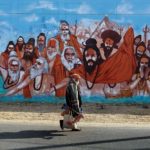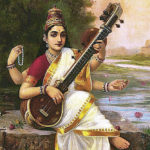God of the Year: Ayyappa – A Life
The evolution of the deity at Sabarimala
 Madhavankutty Pillai
Madhavankutty Pillai
 Madhavankutty Pillai
Madhavankutty Pillai
 |
20 Dec, 2018
|
20 Dec, 2018
/wp-content/uploads/2018/12/Ayappa1.jpg)
IT WAS IN THE YEAR 1989 THAT Chandrahas Shetty, who is 60 years old now, made his first journey to Sabarimala. In the village of Shankarapura in Udupi, Karnataka, he and a few friends got together and decided to go. They took a tempo to Erumeli and then walked 60-odd km to the temple. Conditions weren’t really good. There was very little by way of infrastructure to make the trek pleasant. He remembers the steps leading to the Pamba river soiled with people performing their ablutions on it. “One year, I would go and think that I wouldn’t go the next year,” he says. But his relationship with Sabarimala was only beginning. Inevitably “bhagwaan called” and he set off.
Shetty subsequently moved to Mumbai, where he runs a restaurant and a bank canteen. His Sabarimala pilgrimages continued. He has been there more than 30 times now. In fact, he made it even more arduous for himself. In 2001, along with a few others, he decided to walk all the way from Mumbai, a distance of over 1,500 km, covering it in around a month-and-a-half.
When I speak to him on the phone, he is again on that long walk. He is in Karad, about 300 km away 10 days after the first step. There are 13 of them, all called Swamis. Shetty is the Guru Swami or spiritual guide of the group, the eligibility for this title being multiple pilgrimages. Before starting, a puja is done and they wear rosary garlands. A month before these prayers, they stop wearing footwear. Shetty has as usual taken it a step further. He has not worn any footwear for 12 years now. When they walk, they have no fixed itinerary. They stay at temples or with whoever hosts them. “Wherever Ayyappa stops us, we stop,” he says.
At some point they will reach his village in Udupi, where a few more will join. He says they are guided by the strength their god gives them, which, in turn, comes from faith. And that such a long journey is not possible without Ayyappa’s grace. Why does he do it? What is the benefit? “What is the point in only working and thinking about money? The mind gets peaceful,” he says.
A few things to note about Shetty’s relationship with Ayyappa: it began in the 1980s and was part of a wide increase in popularity of the faith; earlier, Shetty says he knew about people going from his region, but they were far and few. Then there is the mode that Shetty initially took—going by a vehicle, which shows the character of the pilgrimage changing; with multiple routes opening up and the reach of the railways and roads coming close to Sabarimala. In reverting to walking all the way this year, Shetty is an anachronism. The overwhelming majority of those who go to seek the blessings of Ayyappa now trek only a few hours.
Gita Aravamudan, a journalist based in Bengaluru now, had moved to Trivandrum in 1970 and started writing about the Sabarimala pilgrimage. She recounts changes in the demography of pilgrims. “The early people I talked to were all from ordinary middle-class and poorer sections. It was a very well-constructed pilgrimage trip, where you take one month to walk all the way to the temple, do the puja and come back. By the end of the 1970s, Kerala was also slowly opening up as a tourist destination. By the early 1980s, people started taking cars and going a good distance. Then buses started coming from across the different states,” she says.
Traditionally, a 41-day vratham, a vow of austerity and celibacy, is adopted before embarking on the pilgrimage. She noted that working people in Trivandrum would just observe it for two or three days and go, indicating that white-collar workers were increasingly becoming followers. And since you can’t go to your office without footwear, short-cuts were being adopted. And then by the 1990s, celebrities followed suit as Sabarimala became even more popular. “Every big star would have gone there for this pilgrimage,” she says. Now there are temples of Ayyappa dotting the whole country, especially South India. A god who was residing in obscurity on a mountain top till a century ago had come into his own in the Hindu pantheon.
A FEW YEARS AGO, while doing an article on Ganpati, archaeologist and historian Arvind Jamkhedkar had told me about Cave 21 in Ellora that depicts the wedding of Shiva with Parvati. At the head of the procession is Kartikeya and Ganpati. His point was that if Ganpati was the son of the couple, how could he be part of the procession? The answer was that in 550 CE, the period to which the cave is dated, Ganpati was not thought of as a son of Shiva and Parvati— he was only brought into their fold later and this was necessitated by his growing popularity. He would go on to become ever more a part of Hindu lives and is now ubiquitous in Indian homes. Top-tier gods in Hinduism often begin small and then evolve. Belief in Ganpati is so widespread that even in the isolated wilderness of Sabarimala, a little to the southwest of Ayyappa, stands his idol. We can’t pinpoint when Ganpati’s popularity made the big leap, but Ayyappa’s ascent to pan-Indian status as a god is just 50 to 100 years old.
Ayyappa’s ascent to pan-Indian status as a god is just 50 to 100 years old. There are stray references to him in academic texts of the late 19th century, often as part of a larger corpus of gods like Aiyanar and Sastha
There are stray references to him in academic journals of the late 19th century, often as part of a larger corpus of gods like Aiyanar and Sastha, all forms and synonyms of each other. Ayyappa is a merger of these two gods—Aiyanar, who is a popular village deity, and Sastha, a much older and more important deity whose references can be traced back to the 3rd century CE—plus a quasi-historical figure who is related to the Pandalam royal family in some form, depending on the myth. In the most popular form of the story, Ayyappa is the son of Vishnu and Shiva, who takes birth in human form to kill a demon called Mahisi. As a baby, he is adopted by the Pandalam king who has no heir. When the monarch’s wife conceives later, she sends Ayyappa to the forest as a trap to get tiger’s milk. Ayyappa finds Mahisi there and fulfils the prophecy. In another myth, he is a commander-in-chief of the Pandalam king’s army repelling a foreign invader. The kingdom itself was a minor principality in Kerala and so does not explain the scale of Ayyappa’s renown. He is also worshipped in forms that indicate his beginnings were local.
In an 1873 volume of The Indian Antiquary: A Journal of Oriental Research in Archaeology, History, Literature, Languages, Religion, Folklore, Ayyappa is mentioned in an article by the Reverend F Kittel Merkara on ‘Coorg superstitions’. Coorg is on the other side of the Western Ghats from Kerala. Ayyappa is No 1 in a list of the many ‘demons of Coorg’. Merkara describes him thus: ‘Ayyappa (Ayya-Appa), ie Lord-father, a name at present explained as if Ayyappa were the lord of the universe. I think it originally means Demon-master, Appa being a very common honorific. If a person falls under his influence, he will become ill. Ayyappa is also called Male Deva, ie Hill- god, and Bete Ayyappa, ie Lord-father of hunting, and his favour is sought for hunting expeditions. His stone, on a small platform is met with in jungles and gardens. Here and there a whole jungle is dedicated to one of his stones, and out of such jungles superhuman sounds are said by some occasionally to proceed. On his platform models in wood and clay of bows, arrows, dogs, horses, elephants, etcetera are laid as gifts. When a hunt has been successful, an Ayyappa stone is presented with a coconut and some rice, and, according to others, also with a fowl and some arrak in a leaf. The hill-Ayyappa stands nowadays on the boundary between the Kulis (Demons) and Devas (Deities), as is indicated by the fact that no swine—the gifts thought particularly fit for Karanas (Ghosts) and Demons—are offered to him…Another name of Ayyappa in Coorg is Sastavu or Sartuvu. It is also found among the Tamilas and Tulus both of whom consider its bearer to be the master of Demons. In Coorg he is a stone within or outside a temple, with a Brahmin Pujari, and only at some distance from his Puja seat receives fowl-sacrifices from the hands of the Coorgs. Among the Tulus he holds about the same position; among the Tamilas he seems to bear more of the Demon character.’
Following Independence, as India began to stabilise and mature, it also saw a renaissance of Hindu spirituality. In that stream came pilgrimages to places like Sabarimala and Tirupati. Faith in Ayyappa moved in tandem with the beat of the country’s evolution and progress
In his 1893 book On the Original Inhabitants of Bharatavarsa or India, Gustav Oppert has a chapter on Aiyanar, with Ayyappa passing off as a synonym. He writes, ‘In the preceding pages I have repeatedly alluded to Aiyanar by which name the Supreme God of the Gauda- Dravidians is principally known in Southern India, while the Kanarese people call him Ayyappa. He is indeed the highest ruler among the non-Aryan aborigines of this country, and is therefore very appropriately called Sasta, ruler, by which term he is generally named.’
MGS Narayanan, who has done seminal scholarship on the history of Kerala, also says that Ayyappa is a form of Aiyanar who was a guardian deity of villages. “Villages in Tamil Nadu had walls surrounding them and at the entrance there was a deity, a warrior sitting on a horse with a weapon. He was called Aiyanar. And the present-day Ayyappa of Sabarimala is one of those Aiyanar statues,” he says. Narayanan found that traditional songs in praise of Ayyappa (also called Ayyappan or Sasthan Pattu) were all in modern Malayalam and so infers that they couldn’t have been written before the 16th century, placing the cult after that period at least.
Professor Ajit Kumar, founder head, Department of Archaeology, University of Kerala, who is writing an article on Ayyappa to be published in 2019, says the cult seems to have its origin possibly in the 18th century. ‘Because Keralolpathi (a tome on the early history and origins of Kerala) composed in the 17th century does not mention Ayyappa as such,’ he says over email.
Professor Kumar says that Ayyappa was only a minor deity earlier and hence did not initially have individual temples dedicated to him. He also argues that both Aiyanar and Ayyappa are guardian deities. ‘At the Ayyappa shrine at Sabarimala, his assistants who guard the foot of the 18 steps are named Karupu Swami and Kadutha Swami. These are typical names of vogue among lower caste people or among the tribes etc. in ancient times bringing to forth Ayyappa’s non- Brahminical association. In Thurston’s book Caste and Tribes of Southern India it is clearly mentioned that lower caste people worshiped Ayyappa,’ he says.
He feels the historical Ayyappa could be some sort of tribal chieftain or warrior who was under some influence of Pandalam kings, who were feudatories of the Pandya kings, before being subdued and their territories annexed by Marthanda Varma, who ruled the Travancore kingdom from 1729 and 1758.
The relationship of the region’s tribes with Ayyappa has led to calls for a return of Sabarimala to the ‘original’ believers. Malai Arayans claim that Brahmins took over the temple in 1902 and before that it was they who conducted rituals there
There is also a hypothesis that Sastha worship is a leftover of Buddhism which got assimilated into Hindusim—Buddha then came to be known as Sastha. Among the reasons adduced for it is the similarity between the calls of ‘Saranam Ayyappa’ and ‘Buddham/ Dhammam/ Sangham Saranam’ of Buddhism. Also, Sastha temples are located mostly in remote forests areas, which is in keeping with the seclusion maintained by Buddhist monastries. However, the Buddhism theory is repudiated by a majority of scholars, who see scant evidence for it.
In the Proceedings of the Indian History Congress, 3rd Session, Calcutta, 1939, V Narayana Pillai wrote a paper on why Sastha and Buddha cannot be one, noting that just because Buddhists used ‘saranam’ does not necessarily make them the earliest to use this word and that images of Sastha don’t have any resemblance to Buddha. Instead, Pillai favoured the idea that Sastha was in fact a popular Dravidian deity who got incorporated into the Aryan fold when Nambuthiri Brahmins migrated to Kerala. He added, ‘In temples dedicated to Siva or Vishnu or other Hindu deities, a minor shrine will be found where Sasta is installed. Many primitive tribes in Travancore hills— Malay-arayans, Malapandarams, Mannans, Kanikarans, Paliyans, Vizhavans, etc., still worship Sasta as their patron deity. The explanation for this universal prevalence of Sasta worship in Kerala is not far to seek. When the ancestors of the Nambutiris migrated to the west coast their numbers could not have been large. They brought with them the Aryan religion which the earlier inhabitants were persuaded to acknowledge as superior to their religion. The Aryan religion thus prevailed in the country. But the new religion was in its turn influenced by non-Aryan beliefs and forms of worship. Many of the latter were in course of time incorporated with the Aryan religion. The Hinduism of Kerala, as with the rest of India, was thus the result of a fusion of Aryan and Non-Aryan cults. The Sasta worship which is still prevalent among all classes of the people, primitive as well as civilised, is a Dravidian element which was absorbed by the Aryans in the course of the racial and cultural fusion that went on in the country. The contention that Sasta was a pre-Aryan deity worshipped by the earlier inhabitants and that after the immigration of the Aryans the deity was incorporated into the Hindu pantheon is supported by the prevalence of the worship of Aiyanar, the most common village deity, among the people of the east coast. He is the guardian of the village who must be propitiated if the village should prosper. In Hindu mythology Sattan, Sasta, Aiyan, Aiyanar, Aiyappan and Hariharaputra are synonyms used to refer to the same God.’
The relationship of tribes with Ayyappa has led to calls for a return of Sabarimala to the ‘original’ believers. Malai Arayans are one of the main tribes in the region and PK Sajeev is the founder of Aikya Mala Araya Mahasabha, an organisation that works for the welfare of the community. He claims that Brahmins took over the temple in 1902 and before that it was Malai Arayans who conducted rituals for Ayyappa.
Ayyappa’s growing popularity has led to multiple routes opening up to Sabarimala, with railways and roads reaching quite close to the temple now. These days the overwhelming majority of worshippers trek only a few hours
In the version of history that Sajeev puts forth, Ayyappa belonged to their community and lived in the 12th century. When the powerful Cholas attacked the region using an army of Maravar tribesmen, Ayyappa led the resistance using guerrilla warfare and emerged victorious. He says that even those Malai Arayans today who have been driven from the mountains to the valleys inevitably return to their places of worship. Sajeev, who is 47 now, maintains the 41-day vratham and visits the temple every year during the pilgrimage season, his father having first taken him at the age of five or six. “We are only a 30,000 population. But there are more than 100 temples of this community. The majority are Ayyappa temples. [The Sabarimala] temple was founded by Malai Arayan community’s people. This temple should be given to the community. All conducting of rituals should be returned to them,” he says.
Pillai begins his 1939 paper with a statistic: ‘Last year more than two lakhs of pious worshippers are said to have congregated at Sabarimala on the 1st of Makarom.’ A 1957 Bombay Chronicle newspaper feature on the pilgrimage says, ‘Perched on the wildnerness of the thick jungles of Sabarimala, an offshoot of the Sahya mountains in South India, is the sacred temple of Lord Ayyappa, visited by tens of thousands of devotees every year in January.’
THE DIFFERENCE IN numbers can be put down to data collection on pilgrim counts not being an exact science, but it couldn’t have been more than a hundred thousand or two. By the mid-1980s, estimates on the pilgrim count were in the range of 4 to 5 million. In 2016, the minister for the Devaswom, which manages Sabarimala, told the Kerala Assembly that 40 million pilgrims visit the temple annually. That is more than the entire population of Kerala.
According to MGS Narayanan, it was in 1950 that Ayyappa became more than just a popular god at the tip of the Indian peninsula, when the temple was destroyed by arson and the idol vandalised. “That news caught up and people from different parts of the country began to pay attention and make an event of that,” he says.
In the most popular explanation of his origin, Ayyappa is the son of Vishnu and Shiva, who takes birth in human form to kill a demon called Mahisi. As a baby, he is adopted by a Pandalam king who has no heir
There is also an additional factor. Following Independence, as India began to stabilise, mature and develop as a country, it also saw a renaissance of Hindu spirituality, the revival and spread of yoga beyond its borders and godmen like Rajneesh becoming global superstars being instances of that. In that stream also came pilgrimages to places like Sabarimala and Tirupati. Faith in Ayyappa moved in tandem to the beat of India’s evolution and progress. As Radhika Sekar notes in her 1987 doctoral thesis, The Process of Pilgrimage: The Ayyappa Cultus And Sabarimali Yatra, ‘With regard to the emergence of the Ayyappan cultus during a period in which Indian society (and south Indian society specifically) was undergoing transition influenced by global and internal political changes, two issues emerge. First, it has to be pointed out that the Sabarimalai yatra was not the only one to emerge at this time. Several other pilgrimage sites enjoyed an increased popularity. In Tamil Nadu, there was an increased interest in the Amman (goddess) cults.’
Also, Ayyappa was unusual in being a Hindu god who invited people of every religion to worship him. A comrade-in- arms of Ayyappa in mythology is Vavar, a Muslim pirate or spice merchant, to whom there is a shrine on the way to the Sabarimala temple. Pilgrims offer him black pepper along with their prayers. The singer Yesudas, a Christian, has sung some of the greatest hymns to Kerala’s temples. He has never been allowed inside Guruvayoor temple, while he is welcome at Sabarimala.
The only presence that Ayyappa could not bear, and that too only in the Sabarimala temple, was that of women between the ages of 10 and 50 because the form he is worshipped in its sanctum sanctorum is that of an ascetic and celibate. There are other temples, where Ayyappa takes the form of a child and even a householder, that bar no one’s entry. To followers, the Supreme Court judgment permitting women of all ages into Sabarimala was aggression against their god. Hence the intensity of the agitation, which caught the state government by surprise, and the fear of violence and resultant fall in the number of pilgrims this year.
Ayyappa was unusual in being a Hindu god who invited people of every religion to worship him. A comrade-in-arms of Ayyappa in mythology is Vavar, a Muslim pirate or spice merchant who is worshipped at a shrine on the way to Sabarimala
GERMANY-BASED Anjali George was one of the women devotees who became part of what is known as the ‘Ready to Wait’ campaign, which argues against corrupting a tradition in service of the politics of feminism. She was introduced to Ayyappa in her childhood. ‘I grew up in a remote tribal district where Ayyappa devotion was part of daily life during the Mandala season. The Hindus of my locality, including the Vanavasi community, have been enthusiastically observing the vratham mandated for the annual Sabarimala pilgrimage. The bhajans from the Ayyappa Bhajana Madom across the hill still reverberate in my ears. We also had classmates and neighbours who used to go to Sabarimala, and I remember everyone eagerly waiting for the prasadam they used to bring back from the temple. Once a person adorns the maala for the vratham, he gets to be greeted as Ayyappan or Swamy by everyone in the locality. I still remember how we girls used to be considerate of the Ayyappans in our class so that we won’t break their vratham. It came out of our respect and devotion to Swamy Ayyappa. A section of politically-minded feminists who have nothing to do with faith decided that the temple rituals and worship system were wrong. Although these high-decibel feminists enjoy political patronage and media space, we thought we should get the world to hear our voice too. We desperately wanted to tell that as the real stakeholders of the Ayyappa Dharma, the women of Kerala are ‘Ready to Wait’. We used social media to get the message out without any patronage,’ she says over email.
George also alludes to the 1950 arson at the temple as something that led to an increase in its popularity. ‘With the growing reputation, attempts to destroy the Sabarimala temple also grew. A CID report by Kerala’s police clearly mentioned that the temple was set on fire by miscreants in 1950. With each attack, the temple became more and more popular. Films also added to the publicity. The 1975 movie Swamy Ayyappan met with critical acclaim and became a box-office success,’ she says.
George says the aftermath of the Supreme Court judgment has also raised Ayyappa’s popularity across the globe. “Malayalis who have migrated to various countries have built Ayyappa temples there and were organising ‘Save Sabarimala’ Nama Japam wherever they live. This devotion is also a reason for the popularity of Ayyappa Swamy. There is a big group of devotees from Russia, who have been performing Sabarimala pilgrimage for a couple of years,’ she says.
The only presence that Ayyappa could not bear, and that too only in the Sabarimala temple, was that of women between the ages of 10 and 50. There are other temples where Ayyappa takes the form of a child that bar no one’s entry
She talks of tales of miracles bolstering the faith of Ayyappa among adherents. And these tales are constantly replenished. After 2001, Chandrahas Shetty walked from Mumbai to Sabarimala for two more years in succession and then began to space it out over some gaps. In one of those first long walks, they were in Kolhapur and had just finished their meal at a temple when a dog approached them. They chased it away. They stopped for the night at a friend’s hotel and on waking up in the morning found the dog outside. When they went inside and got some biscuits for it, the dog had disappeared. When they reached the highway, it was waiting for them. It became one of the party then. When non-vegetarian food was offered to it, the dog wouldn’t touch it, says Shetty. The dog came all the way to Kerala. At Pamba, the authorities wouldn’t let it go further for the last leg to the temple. And the dog waited. When Shetty returned, he took the dog back and it stayed in his home after that.
Seven years later, when he was on one more long walk from Mumbai to Sabarimala, at Khandala Ghat, yet another dog started following them. This one too found a home with Shetty afterwards. To Shetty, this is a miracle, while to a rationalist there would be nothing extraordinary in such an episode.
Two years ago, a Facebook video went viral that showed a deaf and dumb man from Malappuram saying ‘Swamiye’ clearly and loudly. An association of rationalists from his district went to investigate and found that he wasn’t really talking. He could only say this one word because, as someone going on that pilgrimage for 30 years, it was the only word he had trained his vocal chords for. It being a miracle or not depends on interpretation: whether one word suffices or not. Or whether you take instances of animals hitching on to travelling humans as the wonder of faith or an evolutionary mechanism. In any case, it adds another line to the legend of the God.
About The Author
CURRENT ISSUE
MOst Popular
3

/wp-content/uploads/2025/07/Cover_Crashcause.jpg)













More Columns
Bihar: On the Road to Progress Open Avenues
The Bihar Model: Balancing Governance, Growth and Inclusion Open Avenues
Caution: Contents May Be Delicious V Shoba